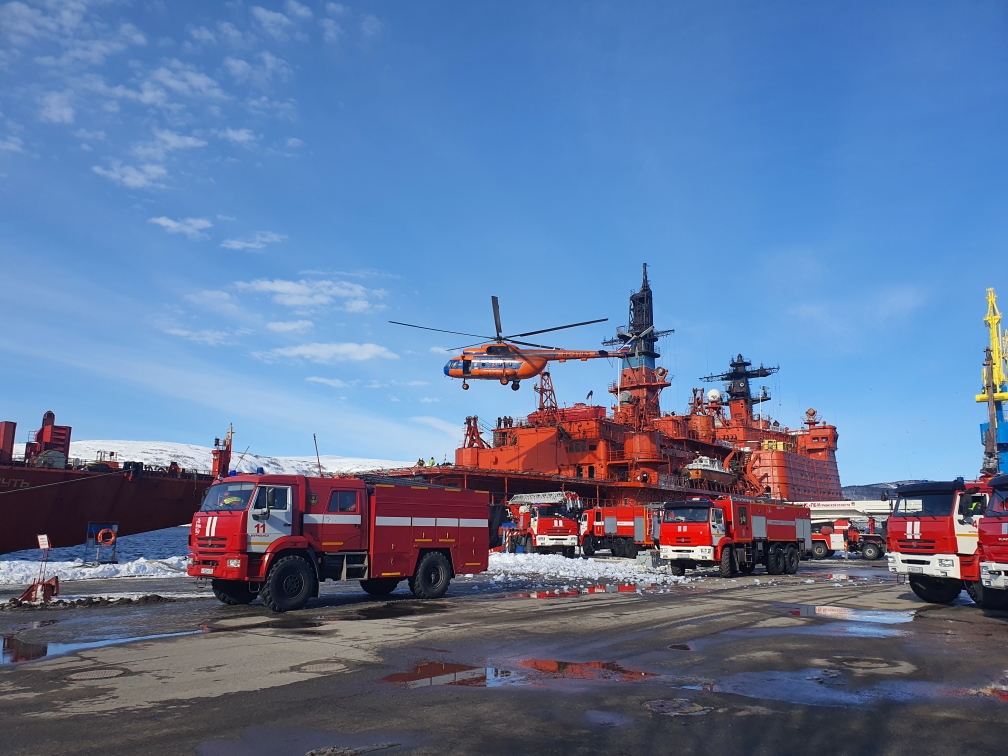
At the plenary session “Main Challenges and New Threats to Security in the Arctic Zone of the Russian Federation”, held as part of the Safe Arctic 2023 exercises in Salekhard, on April 7, Vladimir Panov, Rosatom Special Representative for the Arctic Development, noted that the Plan for the Northern Sea Route development until 2035 envisages emergency and medical equipment onboard the Atomflot icebreakers.
“According to the Plan, the deadline is 2024. One of the nuclear-powered icebreakers assisting vessels in the area of the heaviest traffic of oil tankers in the NSR waters is planned to get additional containerized equipment: oil gathering systems, inflatable booms and adsorbent barrages, a boom boat, a container-type diving system, etc. Besides, six nuclear-powered icebreakers will be additionally equipped with medical equipment,” Vladimir Panov noted.
It is noteworthy that Alexander Kurenkov, Minister of the Russian Federation for Civil Defence, Emergencies and Elimination of Consequences of Natural Disasters opened the "Safe Arctic 2023" exercises, on the basis of Atomflot FSUE in Murmansk, on April 6. Andrey Chibis, Governor of the Murmansk region, and Leonid Irlitsa, Atomflot Acting Director General attended the opening ceremony.
“We must be ready to respond quickly to any threats and challenges that may arise in this region. In the course of the exercise on 9 territorial entities, various ministries, departments, state corporations and organizations within the RSChS (Russian system of prevention and response to emergencies) will work in 16 hypothetical situations based on the most usual risks for the Arctic region of Russia,” said the head of the department.
After the opening ceremony at the Atomflot’s berth, the rescuers began to practice fire extinguishing on the decommissioned icebreaker “Sovetsky Soyuz”. According to the exercises script, the fire occurred on the helipad of the nuclear-powered ship and caused a radiation accident. The Atomflot independent emergency response team and Rosatom Emergency and Technical Center JSC were involved to eliminate the consequences of the accident.
“The crews of the Rosatomflot nuclear icebreakers have repeatedly taken part in rescue operations in the Northern Sea Route waters,” noted Leonid Irlitsa, Atomflot Acting Director General. “Safety is our priority. The sea is unforgiving of mistakes. The crews practice response actions in emergencies according to the schedule. We highly appreciate the cooperation with the Ministry of Civil Defence, Emergencies and Elimination of Consequences of Natural Disasters and welcome the attention to security issues in the Arctic.”
Thirty-nine representatives from thirteen countries observed the actions of rescuers and medical personnel. The emergency team practiced protection of personnel, public and environment in the course of the exercise. The forces and means of the state system for the prevention and liquidation of emergency situations in the region demonstrated their readiness for prompt response and further actions to localize and eliminate the accident caused by an emergency.
The rescuers practiced helicopter evacuation of an injured person from the lead universal nuclear-powered icebreaker “Arktika” in the waters of the Northern Sea Route on the same day.
Background
Safety is one of the key priorities for Rosatom and its companies in their activities. Considerable attention is paid to the improvement of safety culture, introduction of modern methods for labor protection and injury prevention, and use of information technologies. Atomflot takes an active part in this work.
The rescuers practiced 110 experimental research tasks in the course of the Safe Arctic 2023 exercises from April 6 to 7. RSChS group including more than 3.5 thousand specialists and 650 pieces of equipment practiced assistance from the air, on water, underground and on the ground.
Three tasks were set for hypothetical situtions in the Murmansk Region: to eliminate a simulated radiation accident aboard the Atomflot nuclear icebreaker at the berth in the seaport; to practice the actions of the supervisory units and the RSChS forces for population protection in emergency power cutoff; and to rescue workers and bring them to the surface from conditionally flooded mine. The emergency mitigation practice covers 25 experimental and research tasks.